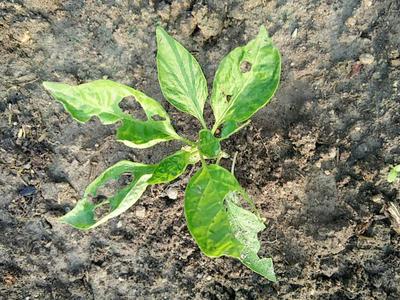Black Cutworm
Agrotis ipsilon
Insect
In a Nutshell
- Small irregular holes on leaves.
- Cut stems at ground level.
- Impaired growth or death.
- Wilting and lodging of plants.
- Grayish brown mottled moths with dark-brown front wings and white back wings.
Can also be found in
Symptoms
Cutworms attack a wide range of crops at all growth stages, but young seedlings are preferred. The damage can be severe if high numbers of caterpillars coincides with the emergence of seedlings and weedy field surroundings. Young caterpillars forage near the ground on weeds or maize if present, leaving small irregular holes on tender leaves. Their older counterparts are burrowed in the soil to avoid the daylight and emerge at night to feed at the base of the plants. Young plants can be dragged underground. Stems can be severed (‘cut’ ) at ground level, resulting in damage to the growing tissues, impaired growth or death. The cutworms can also burrow into the stem which can result in wilting and lodging of older plants.
Recommendations

Organic Control
Cutworms have many enemies including parasitic wasps, flies and predators such as grasshoppers. Bio-insecticides based on Bacillus thuringiensis, Nucleopolyhedrosis virus and Beauveria bassiana provide effective population control. Natural predators should be encouraged by avoiding unnecessary treatment.

Chemical Control
Always consider an integrated approach with preventive measures together with biological alternatives if available. Products containing chlorpyrifos, beta-cypermethrin, deltamethrin, lambda-cyhalothrin can be applied to control cutworm populations. Pre-planting application of insecticides can also help but are recommended only in case large populations are expected.
What caused it?
Black cutworms are robust moths with a grayish brown mottled body. They have light-brown and dark-brown forewings with darker markings toward the outer edge, and white hindwings. They are nocturnal and hide in the soil during the day. Females look similar to males but somewhat darker. They lay pearly white (later light brown) eggs singly or in clusters on plants, on moist ground or in cracks in the soil. The hatching of the larvae depends greatly on temperature and can take from 3 to 24 days (at 30°C and 12°C respectively). Young larvae are light gray, smooth and greasy in appearance, and 5 to 10 mm in length. Older larvae are dark-brown, up to 40 mm long, with two yellow dotted strips running down the back. They feed during the night and during the day and they can be found curled up into a C shape in small shallow tunnels below the soil surface.
Preventive Measures
- Plant early to avoid population peaks of the pest.
- Avoid to plant corn in fields formerly sown with soybean.
- Plow the field to bury larvae or expose them to predators 3 to 6 weeks before planting.
- Plant sunflower plants around the field to attract black cutworms.
- Clear weeds in and around the field before planting and after emergence.
- Use light and pheromones traps to monitor or catch moths.
- Cultivate frequently to injure and expose cutworms to predators.
- Bury plant residues deep in the soil after harvest.
- Keep the field in fallow for some weeks before planting.



